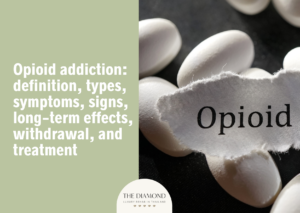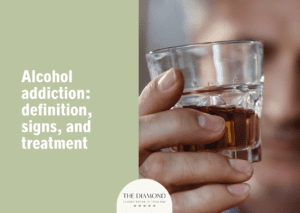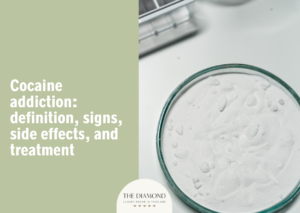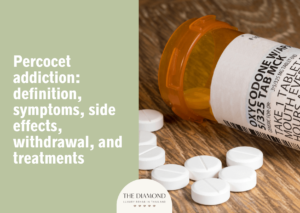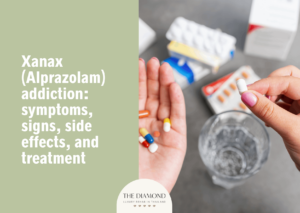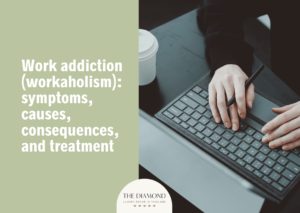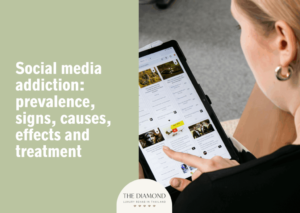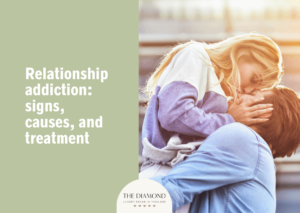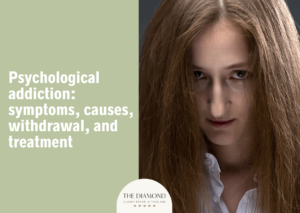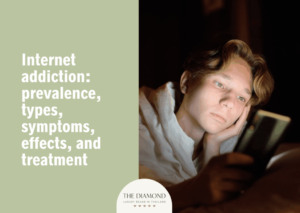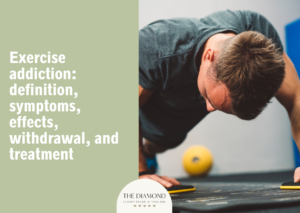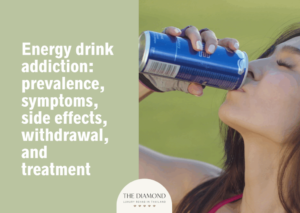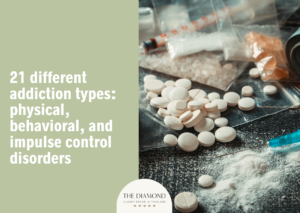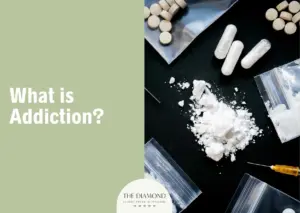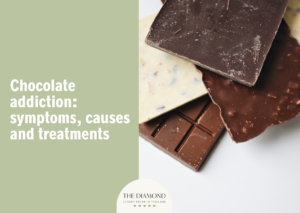What is addiction?
Table of content

Addiction is a chronic disorder marked by strong cravings and persistent involvement in harmful behaviors despite clear negative effects on health or daily functioning. The complex condition reflects a loss of control as the urge to repeat the behavior surpasses awareness of the resulting harm.
The root causes of addiction include neurobiology, genetics, stress, environmental influences, mental health conditions and early introduction to addictive substances.
The types of addiction are physical addiction, behavioral addiction and impulse control disorders.
The signs of addiction include feeling high or euphoric, inability to control use, increased tolerance, paranoia, anxiety, possession of drug paraphernalia, withdrawal symptoms, changes in appetite or weight, neglect of responsibilities, loss of interest in activities, lying or stealing to maintain use and repeated failed attempts to quit.
Treatment options for addiction include cognitive behavioral therapy (CBT), motivational interviewing (MI), medications, rehabilitation, contingency management (CM), support groups and counseling.
The consequences of addiction are physical health problems, mental health issues, damaged relationships, legal and financial problems, loss of employment, social isolation, increased risk of accidents and injuries, as well as overdose and death.
What is the definition of addiction?
Addiction is defined as a chronic disorder in which a person develops an overwhelming reliance on substances or behaviors damaging to overall well-being. It is often described as a lifelong condition because the risk of returning to unhealthy patterns never fully disappears.
The condition is viewed as a relapsing illness, meaning setbacks are common even after treatment or periods of stability. At the core of addiction is both a physical dependence and a mental need driving repeated use or engagement.
The brain’s reward system becomes rewired, producing a strong urge overpowering logical decision-making. Such an urge does not stem from simple choice but signals disrupted brain chemistry. Eventually, the person loses control, finding resistance against the cycle of use increasingly difficult.
What is an addictive drug?
An addictive drug is a substance containing a chemical altering brain activity and encouraging recurrent use. Certain drugs start as a prescribed medication for pain relief or mental health treatment, yet misuse follows when the body adapts.
As tolerance increases, the brain starts to seek the drug, resulting in a stronger dependence with further exposure. Addiction potential varies, with particular substances rapidly creating dependence while others take longer. Substances with high addiction potential usually interfere with dopamine pathways, reinforcing the desire for repetition.
The shift from medical use to compulsive behavior happens gradually and most of the time goes unnoticed until consequences emerge. Once dependence forms, quitting without support results in distressing withdrawal symptoms.
How common is addiction?
Addiction is extremely common. In 2023, 48.5 million individuals aged 12 or older, representing 17.1 percent of the population, had a substance use disorder (SUD) in the preceding year. The figure includes 28.9 million individuals with an alcohol use disorder and 27.2 million individuals with a drug use disorder, according to a 2024 publication from the Substance Abuse and Mental Health Services Administration (SAMHSA), titled “Key Substance Use and Mental Health Indicators in the United States: Results from the 2023 National Survey on Drug Use and Health.”
Young adults between the ages of 18 and 25 made up the largest number (27.1 percent, or 9.2 million people), followed by adults 26 and older (16.6%, or 37.0 million people) and adolescents between the ages of 12 and 17 (8.5 percent, or 2.2 million people).
Is addiction the same as substance dependence?
No, addiction is not the same as substance dependence. Dependence describes physical changes in the body after repeated use, where tolerance and withdrawal occur and the person cannot function normally without the substance. Addiction goes further, combining physical reliance with a mental component driving compulsive behavior.
As a 2021 publication from Szalavitz et al., called “Drug dependence is not addiction—and it matters” explained, physical dependence is a biological response to long-term use of certain drugs. Numerous people on extended opioid therapy for chronic pain develop dependence, yet the situation does not automatically indicate addiction.
Addiction involves brain changes, including epigenetic shifts remaining after withdrawal and reducing control over substance use. Such changes persist for years, defining addiction as a chronic condition rather than a temporary physical state.
Is addiction the same as substance abuse?
No, addiction is not the same as substance abuse. Substance abuse refers to the harmful or risky use of drugs, even if dependence has not developed. Abuse involves taking larger amounts than prescribed, using drugs for non-medical reasons or engaging in patterns harming health and relationships.
Addiction, on the other hand, reflects a condition where the brain undergoes changes fueling cravings and loss of control. Someone can abuse a drug without becoming addicted, but addiction almost always includes a history of abuse.
Understanding the difference between drug addiction vs. drug abuse is important for both diagnosis and treatment. Abuse highlights dangerous behavior, while addiction describes a condition reshaping brain function and behavior.
In addiction, the compulsion to use persists even after severe repercussions arise. Abuse is more likely to stop with changes in behavior, but addiction usually requires structured treatment.
Is addiction the same as substance use disorder (SUD)?
No, addiction is not the same as substance use disorder (SUD). SUD is a medical diagnosis covering a wide spectrum of problematic drug or alcohol use. SUD ranges from mild patterns, where harmful consequences are present but limited, to more advanced stages with significant disruption.
Addiction represents the most severe form of the spectrum, where compulsive use and loss of control dominate daily life. In clinical settings, severe SUD is often used interchangeably with addiction, yet the two terms are not identical. Addiction emphasizes the brain changes and compulsions keeping the cycle going, while SUD serves as the broader diagnostic framework.
A person with mild or moderate SUD does not always progress to addiction. Severe SUD, however, reflects a stage where behavior and brain function become deeply intertwined.
What are the root causes of addiction?
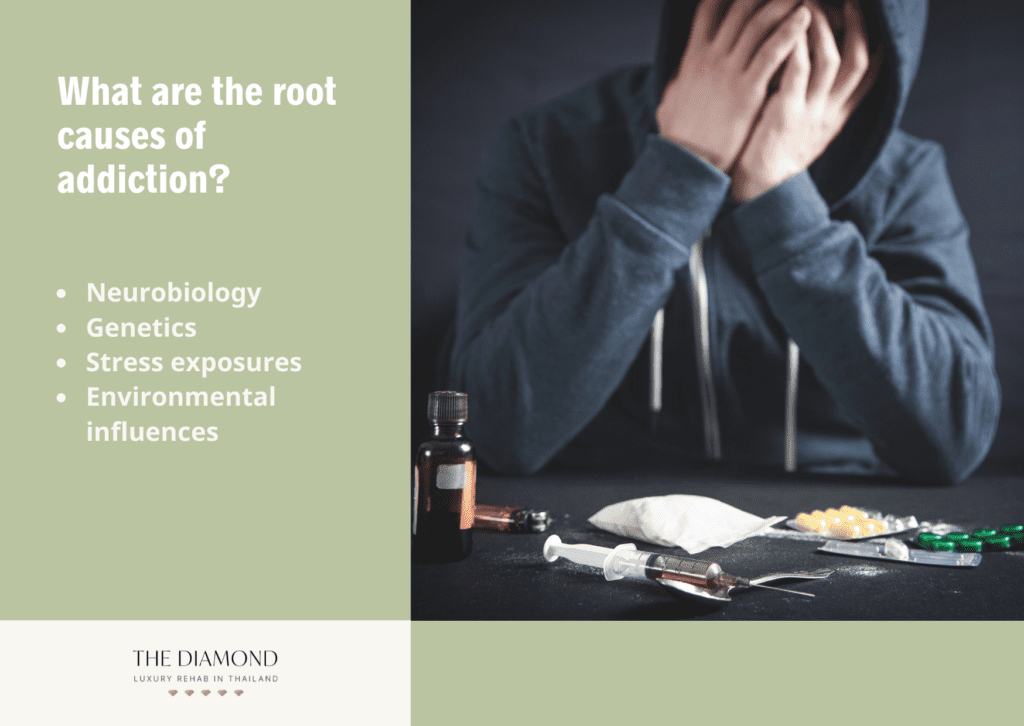
Root causes of addiction are the initial circumstances fostering the emergence of compulsive drug use. The root causes of addiction are listed below.
- Neurobiology: Addictive substances disrupt the brain’s reward circuitry by triggering an abnormal surge of dopamine. The artificial boost creates intense feelings of pleasure, reinforcing repeated use. As natural production declines, the brain struggles to generate satisfaction on its own. People then rely more heavily on drugs to reproduce the same rewarding effects.
- Genetics: Family history plays a significant role in shaping vulnerability to addiction. According to a continuing education activity titled “Drug Addiction” by Fluyau et al., last updated in January 2024, one clue scientists discovered involves a protein called Delta-FosB. The protein accumulates in specific brain cells after repeated drug use. As Delta-FosB gathers, brain cell function shifts, increasing cravings and reinforcing drug-taking behavior. Researchers observed the same buildup after compulsive running, suggesting Delta-FosB connects to drugs as well as various compulsive habits.
- Stress: Chronic stress places heavy strain on the body and mind, making escape through substances feel appealing. Stress hormones affect the brain’s ability to regulate impulses, heightening the chance of risky use. Parental and family stress reduces quitting ability, with stress states accurately predicting treatment interruptions. Stressful conditions enhance the likelihood of relapse, as does a lack of coping abilities, according to a 2025 paper by Liu et al., called “A study on the effects of addiction level, stress, and social support of drug relapse patients on changes in motivation of quitting substance misuse behaviors.”
- Environmental influences: Circumstances such as trauma or peer pressure strongly shape the path toward addictive behavior. Traumatic experiences leave lasting emotional wounds, encouraging self-medication through drugs or alcohol. Influence from peers normalizes risky use, reducing hesitation and encouraging experimentation. The surrounding environment, therefore, sets conditions either guarding against or promoting addiction.
- Mental health conditions: Disorders such as depression or anxiety frequently overlap with substance use. Individuals seek relief from emotional distress through chemicals providing temporary numbness. Such self-medication strengthens dependence, merging two health struggles into one. Without addressing both issues together, recovery becomes far more difficult to sustain.
- Early introduction to addictive substances: Introducing drugs or alcohol during adolescence interferes with normal brain development. The immature brain becomes more sensitive to the reinforcing effects of addictive substances. Early use lays patterns persisting into adulthood, making lifelong dependence more likely. Prevention during youth is critical for reducing future risks.
How does addiction start?
Addiction starts with the introduction of a substance or behavior triggering the brain’s reward system. The initial experience instills a strong sense of pleasure, prompting further participation. The brain adjusts to such experiences with repeated use, requiring more to produce the same result.
Such changes weaken natural reward responses, making ordinary activities feel less satisfying. Cravings intensify as the brain begins to associate the substance or behavior with relief or excitement. Control eventually slips away, and seeking pleasure becomes the main focus.
An article by Abdo Semaan and Mashal K. Khan titled “Neurobiology of Addiction” last updated in November 2023 revealed most people’s first experience with substances is characterized by impulsivity.
Most participants in a 2023 study by Mahsoon et al., titled “Socio-Demographics of Initial Substance Use Exposure and Its Relation to Progression: A Cross-Sectional Study in Saudi Arabia” began abusing substances between the ages of 19 and 23, initially consuming drugs with peers in high school. Teenage curiosity and joy-seeking were the primary motives for initial drug use.
What is dopamine?
Dopamine is a neurotransmitter and hormone essential for communication between nerve cells in the brain. It plays a central role in the brain’s reward system, guiding how people respond to positive experiences.
When released, dopamine links enjoyable feelings with specific actions, encouraging repetition of certain behaviors. The connection motivates individuals to seek food, social interaction or achievements bringing satisfaction.
Through reinforcing behavior with pleasure, dopamine ensures survival-driven activities continue. However, the same system becomes vulnerable when substances or compulsive activities trigger excessive dopamine release. Repeated surges create stronger associations, convincing the brain to prioritize artificial sources over natural rewards.
What are reinforcing stimuli?
Reinforcing stimuli are events or experiences increasing the likelihood of a behavior being repeated. A reinforcer works by creating a link between an action and a desirable consequence. When the outcome feels rewarding, the brain encourages the same behavior again.
Food, social approval or relief from discomfort all act as reinforcers depending on the situation. In the context of addiction, drugs or compulsive activities serve as powerful reinforcing stimuli because they trigger intense pleasure. The brain then records the consequence as valuable, strengthening the drive to return to the substance or activity.
What are rewarding stimuli?
Rewarding stimuli are influences encouraging the repetition of certain behaviors through positive reinforcement. A rewarding stimulus enhances the relationship between an activity and a desired consequence, influencing habit formation.
Such cues, in line with neuroscience, activate parts of the brain linked to motivation and pleasure, increasing the persistence of behaviors. Rewarding stimuli tend to vary across individuals, as what feels rewarding to one person does not always hold the same value for another.
Exercise, for example, often functions as a rewarding stimulus because physical activity produces endorphins, chemicals known to enhance mood and promote resilience. The presence of a rewarding stimulus directs attention, decision-making and long-term behavioral patterns.
In certain contexts, such stimuli support survival needs, while in others, the same forces contribute to reinforcement of addictive tendencies. The boundary between adaptive and maladaptive rewarding stimuli frequently defines whether behaviors stay beneficial or turn destructive.
Why do people get addicted?
People get addicted because substances or behaviors trigger changes in brain chemistry, disrupting normal regulation. Chemical imbalance in the brain alters pleasure circuits, pushing the brain to connect certain actions with powerful reward signals.
Once the signals dominate, cravings take control and override healthier decision-making. Genetics increase risk as inherited traits influence sensitivity to addictive effects. Environment adds further influence, with peer pressure, community surroundings and exposure during youth shaping vulnerability.
Family background contributes as well, since both observed behavior and inherited predispositions combine. Stress heightens the struggle, making a person seek relief through substances or compulsive actions.
Is addiction hereditary?
Yes, addiction is hereditary because inherited traits increase the likelihood of developing dependence. Variations in brain chemistry influence how substances affect individuals, creating differences in risk levels.
Specific gene patterns alter reward sensitivity or withdrawal responses, heightening the pull toward compulsive use. Addiction often runs in families, showing the combined impact of biology and shared surroundings. Children raised in households with substance misuse experience both increased susceptibility and environmental pressures.
Still, heredity alone does not dictate outcomes, as environment and lifestyle decisions remain powerful factors. Stress, trauma and peer influence trigger addictive patterns in individuals with genetic susceptibility. Protective factors such as supportive family ties and healthy coping methods help buffer addiction risks.
Can you get addicted if you use a drug just once?
No, you can’t get addicted if you use a drug just once. Initial experimentation is likely to cause temporary euphoria, but addiction develops through repeated exposure. Lasting changes in brain circuits take time to form, meaning one experience alone does not establish dependence.
It is possible for a person to misuse a substance once or twice without developing a chronic disorder. Addiction develops through a gradual process as cravings strengthen, tolerance builds and control diminishes. A single use tends to spark curiosity or lead to risky behavior, yet it does not equal addiction.
The difference lies in frequency and pattern, not a single event. While early use raises the likelihood of continued experimentation, most individuals do not become addicted to drugs after one exposure.
What are the types of addiction?
Types of addiction describe the broad categories used to understand how compulsive patterns of behavior and substance use take shape. The types of addiction are listed below.
- Physical: Problems with tolerance-forming drug and substance usage over an extended period of time constitute physical addiction. The body expects the presence of the drug to maintain stability, so removing the substance triggers painful or dangerous withdrawal reactions. Dependency demonstrates how deeply a foreign substance becomes woven into biological systems. Effective care must stabilize the body first before long-term recovery strategies take hold.
- Behavioral: In contrast to chemical addictions, behavioral addictions are defined by an overwhelming urge to partake in detrimental behaviors on a regular basis. Activities like gambling or excessive gaming take center stage in daily life, progressively displacing obligations and relations with others. Unlike substance-based conditions, the addictive pull here stems from psychological reinforcement and learned patterns.
- Impulse control disorders: Despite being aware of the possible negative outcomes, people with impulse control disorders frequently feel strong urges to participate in particular behaviors. Uncontrolled purchasing or taking unnecessary risks are examples of addiction types extending beyond substances. The drive behind impulses makes daily life unstable and sets off patterns almost impossible to ignore.
What are the signs of addiction?
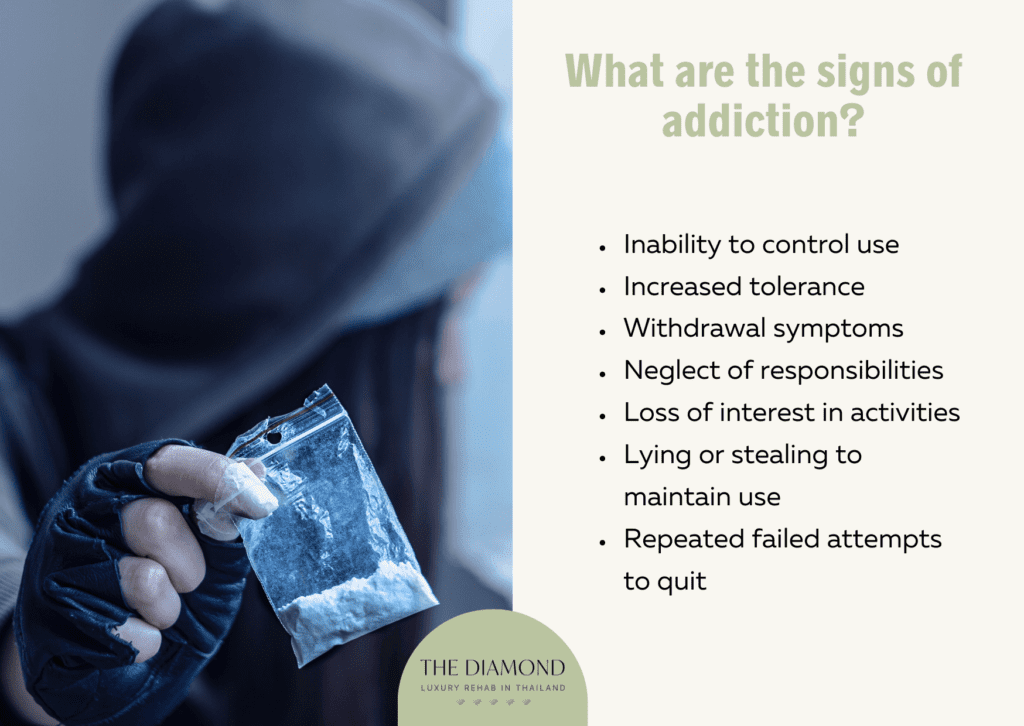
Signs of addiction refer to the observable indicators revealing a person is caught in a harmful cycle of substance use. The signs of addiction are listed below.
- Feeling high or euphoric: A surge of intense pleasure often follows substance use, creating a sharp contrast with ordinary emotions. The rush fosters a psychological link between the substance and escape, pushing a person to repeat the experience. Each episode strengthens the memory of comfort or thrill, embedding the desire more deeply.
- Inability to control use: A strong indicator of addiction emerging when a person struggles to limit how much or how frequent substances are consumed. Even after promising to cut back, the urge overrides intentions and leads to continued intake. Failed attempts to manage usage create frustration and self-blame, deepening the cycle of dependence.
- Increased tolerance: As substance exposure continues, the body adapts, reducing sensitivity to the usual amount. Such a shift pushes individuals to seek larger doses in pursuit of the same effect once achieved with less. Escalating use not just heightens health risks but strengthens reliance on the substance as well. Tolerance signals the brain and body undergoing significant adjustment, anchoring the cycle of addiction more firmly.
- Paranoia: Extended substance use triggers irrational suspicion and intense fear, causing the person to misinterpret harmless situations as threatening. Instead of recognizing situations as neutral, the individual reads hostility or threat into everyday moments. Relationships suffer because trust erodes, leaving the person defensive or withdrawn. Even safe environments feel hostile, leaving the individual tense and disconnected from reality.
- Anxiety: Addiction frequently heightens nervous tension, leaving a person restless even in calm situations. Racing thoughts make concentration difficult, and the body reacts with a pounding heart or rapid breathing. Everyday tasks start to feel overwhelming as the mind anticipates problems never realized.
- Possession of drug paraphernalia: Objects linked to substance use, such as pipes, syringes or rolling papers signal ongoing involvement with drugs. Drug-related equipment reveals preparation for future use and not just a single isolated event. Discovering paraphernalia in personal spaces usually raises concern among family or friends who notice the connection.
- Withdrawal symptoms: When substance levels drop in the body, uncomfortable reactions emerge, ranging from sweating or shaking to nausea. Emotional shifts such as irritability or sadness appear alongside the physical strain. Withdrawal from drugs and alcohol is a prevalent medical issue. The projected global prevalence of withdrawal among adults is 18.4% for heavy episodic alcohol use, 15.2% for daily tobacco smoking, 0.77% for amphetamines, 0.37% for opioids and 0.35% for cocaine, according to a continuing education activity by Regina et al., called “Withdrawal Syndromes,” last updated in September 2024.
- Changes in appetite or weight: Addiction frequently disrupts normal eating habits, leading to either a sharp increase or decrease in food intake. Certain substances suppress hunger, leaving the body deprived of essential nutrients. Others intensify cravings, causing rapid weight gain and placing stress on overall health. Findings of a 2023 paper by Mahboub et al., titled “Patterns and Determinants of Weight Gain among People Who Use Drugs Undergoing Treatment for Recovery in Lebanon” revealed the majority of participants gained a significant amount of weight, particularly during rehabilitation, where increases averaged more than 10 kg. The results indicate treatment settings, especially inpatient ones, encourage quick weight changes due to the constant availability of food.
- Neglect of responsibilities: Daily obligations begin to slip when substance use takes priority over commitments. Jobs, academic performance and household tasks suffer as reliability fades. Missed appointments and unfinished duties strain trust with colleagues and family members. Overlooked responsibilities gradually affect stability, leaving lasting consequences in both personal and professional life.
- Loss of interest in activities: Hobbies and pastimes once bringing excitement no longer hold the same appeal under the weight of substance use. Social events start to feel unimportant, leading to isolation from friends or communities. Even simple pleasures, such as listening to music or exercising, lose spark as the brain prioritizes the addictive substance. The fading enthusiasm narrows life down to the cycle of seeking and using, cutting away sources of joy and fulfillment.
- Lying or stealing to maintain use: Dishonesty becomes a recurring tactic when someone feels pressure to hide substance involvement. Excuses are crafted to explain missing money, unusual absences or secretive behavior. In certain cases, theft replaces lies, with valuables taken to fund the next dose.
- Repeated failed attempts to quit: Numerous individuals promise themselves or others how the next attempt is going to succeed, yet the cycle resumes. Each effort starts with determination, but cravings and withdrawal drag progress backward. A 2019 study by Kelly et al., titled “How Many Recovery Attempts Does it Take to Successfully Resolve an Alcohol or Drug Problem? Estimates and Correlates From a National Study of Recovering U.S. Adults” showed a decrease in quality of life, happiness and self-esteem, as well as an increase in psychological distress and recovery capital were associated with more attempts at recovery.
What indicates the presence of an addiction?
Needing to rely on a substance frequently indicates the presence of an addiction. The drive to consume becomes less about choice and more about satisfying an internal demand. Cravings grow stronger as the brain links relief and pleasure directly to the substance.
Attempts to cut back usually fail, leaving the person caught between intention and action. Physical cues like tolerance and withdrawal reinforce the cycle, making continued use seem unavoidable. Mental distress, including anxiety or paranoia, worsens as dependence deepens.
What are the treatments for addiction?
Treatments for addiction describe several therapy modalities meant to assist patients in overcoming substance dependency. The treatments for addiction are listed below.
- Cognitive behavioral therapy (CBT): CBT trains individuals to recognize destructive thoughts and redirect thinking toward healthier perspectives. People are given the necessary techniques to handle stress in a healthy way, without resorting to illicit substances. Resilience and self-awareness are enhanced via regular practice.
- Motivational interviewing (MI): Guided dialogue helps individuals explore personal reasons for pursuing sobriety. Therapists encourage self-reflection rather than confrontation, promoting inner motivation. A collaborative style of communication strengthens confidence and determination to change. Commitment to sobriety grows stronger as individuals align choices with personal values.
- Medications: Medications are used in the treatment of addiction to help manage withdrawal symptoms, reduce cravings and treat co-occurring mental health disorders. For instance, opioid addiction is treated with medications such as buprenorphine and methadone to alleviate withdrawal symptoms and cravings, according to a 2020 publication from the National Institute on Drug Abuse titled “Treatment and Recovery.”
- Rehabilitation: A structured program delivers both medical and psychological support in a safe setting. Inpatient facilities provide round-the-clock monitoring during the early and fragile stages of healing. Daily routines in a rehab typically combine therapy, wellness activities and education about the impact of substances. Such environments remove outside distractions, allowing full concentration on recovery.
- Contingency management (CM): CM reinforces positive behavior through tangible rewards, such as vouchers or privileges. Incentives encourage consistent attendance in therapy and substance-free test results. Through linking healthy actions to real benefits, accountability becomes part of recovery. A 2021 paper by Ginley et al., called “Long-Term Efficacy of Contingency Management Treatment Based on Objective Indicators of Abstinence From Illicit Substance Use up to 1 Year Following Treatment: A MetaAnalysis” revealed CM significantly increased abstinence odds by 22% up to 1 year post-treatment compared to controls, with low-moderate variability, suggesting the benefits remain consistent and extend well past the immediate recovery period.
- Support groups: Support groups, such as Alcoholics Anonymous (AA) and Narcotics Anonymous (NA), provide peer support and a sense of community for individuals in recovery. Support groups complement other treatments by offering ongoing support and reducing feelings of isolation.
- Counseling: Individual, group and family counseling are crucial components of addiction treatment. Sessions with a therapist provide a safe place to explore emotions linked to substance use. Counselors work to identify the underlying causes, including family conflict, stress or trauma. Better coping strategies and emotional development are promoted by the approach.
How to stop addiction?
To stop addiction, one must first become aware of what sets off the addiction and then devise plans to cope with those triggers. Avoiding environments where drugs or alcohol are present reduces temptation and lowers relapse risk.
Surrounding oneself with friends who live substance-free encourages healthier choices and provides emotional support. Developing the capacity to withstand urges aids in keeping control throughout trying times.
Finding positive ways to manage stress, such as meditation or relaxation techniques, keeps pressure from leading back to substance use. Staying active with exercise or enjoyable hobbies like music creates healthy distractions and natural feelings of reward.
Setting up a planned daily schedule cuts down on free time, lowering the risk of cravings and setbacks. People seeking out professional support through therapy or counseling are better able to overcome adversity and find a way back to health.
Joining support groups introduces accountability and encouragement from people sharing the same journey. Staying drug-free for the long haul is within reach with determination and the help of loved ones.
How long does it take to break an addiction?

Breaking an addiction requires different amounts of time depending on the substance involved and the intensity of use. Nicotine recovery usually lasts 8 to 12 weeks, as cravings lessen and the body adjusts to functioning without constant stimulation.
Alcohol withdrawal and adjustment generally extend 3 to 6 months, since the brain and body need more time to stabilize. Recovery from broader substance abuse often takes six to twelve months, as dependence on stronger drugs usually creates deeper physical and psychological challenges.
The process of breaking an addiction does not follow a uniform timeline, since each person responds differently to treatment and support. Certain people move through the early phases quickly but struggle later with cravings, while others need extended time during detoxification.
Does relapse mean the treatment failed?
No, relapse does not mean the treatment failed. According to a 2020 article from the National Institute on Drug Abuse titled “Treatment and Recovery,” the chronic nature of addiction means relapse, or a return to drug use after an attempt to quit, often becomes part of recovery for certain individuals.
Treating chronic illnesses requires shifting deeply ingrained behaviors, and relapse does not signify treatment failure. When a person recovering from addiction relapses, the experience signals a need to meet with a doctor to restart therapy, make adjustments or pursue another treatment approach.
Rather than being viewed as failure, relapse functions as an opportunity to strengthen treatment approaches. Various individuals benefit from revised strategies, new medications or more structured support to reduce the risk of future episodes.
Incorporating relapse prevention techniques through steady participation in therapy and reinforcing accountability with support networks helps lower the chance of repeating the cycle.
How long does rehab take?
Rehab takes anywhere from about 14 to 30 days for shorter programs and 60 to 90 or more days for longer ones. Shorter stays focus on detox and initial stabilization, giving individuals a foundation to begin recovery.
Longer programs typically offer more intensive relapse prevention strategies and prolonged therapy. While a shorter program aids in managing withdrawal symptoms right away, it leaves less time for tackling more complex behavioral habits.
With more time to address the root reasons of substance use and to help clients build healthy behaviors, a lengthier program is preferred by patients with more severe substance use disorders.
Length of stay depends on the severity of dependence, co-occurring mental health issues and progress during treatment. Certain patients start with a shorter stay and transition into a longer program to reinforce stability. Others return for additional treatment if relapse occurs, extending the overall timeline.
What is detoxification?
The process of assisting the body in safely adjusting to the lack of toxic substances following extended use is known as detoxification. Detox begins with clearing the system of alcohol or drugs while monitoring withdrawal symptoms under medical supervision.
The removal of dangerous substances interfering with regular bodily and brain processes remains the top priority. The approach diminishes physical reliance and readies an individual for the subsequent phase of treatment.
Drug detoxification serves as the initial step in recovery, setting the stage for counseling, behavioral therapies and long-term strategies. Without the foundation set by detox, treatment becomes less effective since toxic substances remain in the system.
What is withdrawal?
Withdrawal refers to the physical and psychological symptoms appearing once a person stops using a substance after developing dependence. The body struggles to adapt without the chemicals it has grown used to, leading to discomfort and distress.
Depending on the drug, symptoms range from anxiety or irritation to sweating, nausea and shaking. In more severe cases, withdrawal involves seizures, hallucinations or dangerous changes in heart rate.
For the process to be safe and less complicated, medical supervision is required. Drug withdrawal emphasizes how profoundly drugs change the chemistry of the brain, making it extremely difficult to cease without professional assistance. Professional treatment eases the transition through medications and adjunctive therapies.
What is dual diagnosis?
Dual diagnosis is when a person experiences both a substance use disorder and a mental health condition at the same time. The combination tends to complicate treatment because each issue intensifies the other.
For example, depression or anxiety drives an individual to misuse drugs or alcohol, while substance use worsens existing psychiatric symptoms. Addressing just one condition leaves the other untreated, leading to a higher risk of relapse.
Comprehensive care for dual diagnosis involves therapy, medication and supportive services to stabilize mental health while reducing dependence on substances. Recovery tends to take longer, as progress must balance emotional wellbeing with physical healing.
What are the consequences of addiction?
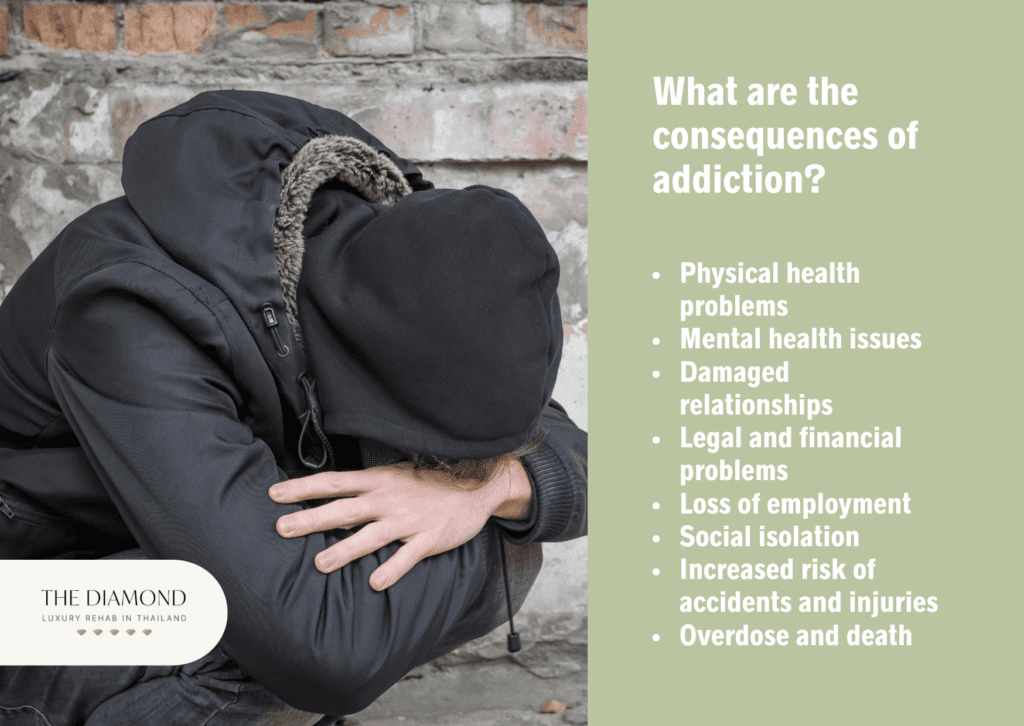
Consequences of addiction are the adverse effects resulting from the protracted use of substances and dependence. The consequences of addiction are listed below.
- Physical health problems: Addiction leads to a wide range of physical health issues, depending on the substance involved. For example, drug and alcohol addiction cause liver disease, heart problems, respiratory issues and a weakened immune system. Over time, the body’s organs and systems deteriorate due to prolonged substance abuse.
- Mental health issues: Addiction exacerbates existing mental health disorders or contributes to the development of new ones. Research indicates adolescents with substance use disorders experience elevated rates of co-occurring mental illness; more than 60 percent of adolescents in community-based treatment programs for substance use disorders meet diagnostic standards for an additional mental health condition, as noted in a publication titled “Common Comorbidities with Substance Use Disorders Research Report” revised in April 2020 by the National Institute on Drug Abuse.
- Damaged relationships: Damaged relationships develop because substance use shifts attention away from family and friends toward obtaining and using drugs or alcohol. Trust declines as repeated disappointments and dishonesty create distance. Loved ones feel abandoned or pushed aside, leading to resentment.
- Legal and financial problems: When money gets directed toward illicit substances instead of essentials, debt and unpaid obligations follow. Encounters with law enforcement become more likely through possession charges or impaired driving. Financial strain deepens once court fees or fines enter the picture, adding weight to an already unstable situation. Employment loss connected to poor performance or absenteeism worsens both the legal and financial fallout.
- Loss of employment: The effects of addiction, such as decreased concentration, absenteeism and poor decision-making, affects an individual’s ability to perform at work, resulting in job loss. As per a 2023 paper by Nolte-Troha et al., titled “Unemployment and Substance Use: An Updated Review of Studies from North America and Europe,” unemployed individuals exhibit elevated SUD rates across substances, with bidirectional causality: job loss triggers substance use as coping, while SUD impairs employability.
- Social isolation: Substance dependence frequently pushes individuals away from social circles as shame and secrecy increase. Invitations to gatherings get declined, and contact with friends or family gradually fades. Isolation deepens once relationships deteriorate and trust disappears. Loneliness eventually replaces support, leaving the person disconnected from meaningful human connection.
- Increased risk of accidents and injuries: Impaired concentration and slowed reflexes appear after consuming substances, creating unsafe conditions. Intoxication leads to falls or burns. Motor vehicle accidents become more common as reaction time slows and awareness fades. A 2020 study by Michaud-Germain et al., titled “Contribution of Substance Use in Acute Injuries With Regards to the Intent, Nature and Context of Injury: A CHIRPP Database Study” found out of 12,857 patients treated in emergency departments, 3.6 percent of accidental injuries involved substance use, while 26.2 percent of injuries caused by others and 38.9 percent of self-inflicted injuries showed the same factor. Substance involvement increased the likelihood of intentional harm by roughly 7.5 times compared with unintentional injuries.
- Overdose and death: Excessive drug intake overwhelms the body’s natural functions, causing breathing or heart activity to slow or stop. Overdose risk rises once tolerance shifts, particularly after a break in use. Immediate medical attention becomes critical, though survival depends on timely response. Continuous exposure to high doses heightens the danger of death, marking overdose as one of the most severe outcomes of addiction.
Can addiction lead to mental health issues?
Yes, addiction can lead to mental health issues. Extended substance abuse interferes with brain chemicals regulating emotion and cognition. Such disruption produces lasting depression or anxiety even after drug use ends.
The relationship between addiction and psychological instability remains closely linked, as each condition reinforces the other’s impact. Repeated exposure to substances places heavy stress on the nervous system, heightening vulnerability to developing a mental disorder.
The link between SUD and declining mental health is further strengthened by genetic factors and environmental stressors. Mental illness frequently occurs alongside addiction, forming a cycle increasingly difficult to escape without professional support.
What are some movies about addiction?
Movies about addiction pertain to films portraying the experiences of individuals grappling with substance dependence. Some of the movies about addiction are listed below.
- Requiem for a Dream (2000): In a compelling psychological thriller, Darren Aronofsky explores the catastrophic effects of substance abuse on four people whose lives fall apart due to drug use. The movie is known for its haunting visual style and unflinching depiction of addiction’s harsh realities.
- Trainspotting (1996): Directed by Danny Boyle, Trainspotting follows a group of young heroin addicts in Edinburgh, Scotland, focusing on the life of Mark Renton as he attempts to escape his drug-fueled existence. The film captures the extreme highs and crushing lows of addiction, revealing the chaos, loneliness and recklessness surrounding dependence.
- A Star is Born (2018): Directed by Bradley Cooper, the musical drama presents the story of Jackson Maine, a veteran musician whose career collapses under the weight of substance dependence. After meeting and falling for a gifted singer named Ally (played by Lady Gaga), his ongoing battle with addiction slowly damages their bond and undermines his capacity to nurture her growing success.
- Flight (2012): The story centers on an airline pilot who saves passengers after a crash but faces exposure for substance dependence. During an official investigation, his denial and guilt start to fall apart. Accountability, truth and the public’s perception of addiction’s effects are all themes explored in the story. Flight powerfully portrays how control crumbles despite outward confidence.
- Beautiful Boy (2018): Based on true events, the film tells of a father supporting his son through repeated meth dependence and relapses. Emotional distance and unconditional love clash as both struggle to understand one another. The story captures the exhaustion of witnessing someone fight addiction while holding on to optimism.
- The Basketball Diaries (1995): The film traces a young athlete’s descent from promise to destruction through heroin dependence. Dreams of success vanish as crime and desperation take over. Young people ensnared in the grip of addiction are shown in a vulnerable light in the story. The Basketball Diaries conveys a chilling message regarding the rapid demise of one’s life once dependency sets in.
- 28 Days (2000): The drama follows a journalist sent to rehab after a highly public incident exposes her substance use. Resistance to treatment turns into reluctant acceptance as she begins confronting personal truths. Recovery challenges her to rebuild purpose and trust in herself.
What are some songs about addiction?
Songs about addiction are musical works conveying information about the complicated reality of living with SUD. Some of the songs about addiction are listed below.
- “Under the Bridge” by Red Hot Chili Peppers: Lead singer Anthony Kiedis wrote “Under the Bridge” about loneliness experienced during a period of substance dependence. The song conveys his feelings of alienation and need for connection while grappling with past addiction. The words express a need for connection and peace.
- “The A Team” by Ed Sheeran: The A Team tells the story of a young woman trapped in addiction and poverty. Ed Sheeran captures, with striking visuals, the harsh reality faced by people living on the periphery of society. The emotional impact is haunting due to the stark contrast between the gloomy subject matter and the tranquil melody.
- “Rehab” by Amy Winehouse: Amy Winehouse delivers a defiant narrative about her refusal to enter treatment despite external pressure. Denial and resistance are two characteristics of substance dependence emphasized in the lyrics. The premise of Winehouse’s lyrics (her reluctance to face her addiction) tragically predicted her battles with drugs and early demise.
- “Mr. Brownstone” by Guns N’ Roses: Written during the band’s early years, the song addresses the band’s experiences with heroin addiction. The lyrics use the term “Mr. Brownstone” as a metaphor for the substance itself. The aggressive rhythm mirrors the chaotic lifestyle associated with heavy substance use.
- “Sober” by P!nk: In “Sober,” P!nk explores the idea of using substances to cope with emotional pain and the struggle to find happiness without relying on alcohol or drugs. The conflict between the desire to feel good and the idea of substance usage being ultimately harmful is explored in the song.
- “Recovery” by James Arthur: The track centers on the process of rebuilding one’s life after addiction. James Arthur’s lyrics place a strong emphasis on taking responsibility and wanting to feel good about oneself again. He brings to life the emotional burden of starting over through his moving performance. A message of perseverance and self-discovery is conveyed by the song.
- “Sober” by Tool: Tool’s Sober uses somber, philosophical lyrics to examine issues of internal turmoil and dependence. The band approaches the subject with intensity, merging eerie instrumentals with emotional depth. The conflict between self-awareness and destructive action is reflected in the song’s cryptic message.


